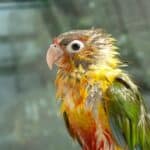Last Updated on January 28, 2024 by Carrie Stephens
It’s alarming to witness a parrot suddenly lose its balance without explanation.
It’s unlikely the parrot lost its footing since birds possess natural balancing skills. Birds use their vestibular system and lumbosacral organ (LSO) to balance when perching.
Ataxia affects parrots’ nervous and musculoskeletal systems, leading to balance loss. Parrots with ataxia appear clumsy and stand with splayed legs to maintain balance.
Ear infections, brain injuries, tumors, and nutritional deficiencies are among the other possible causes.
What Causes Loss of Balance in Parrots?
A parrot showing signs of wobbliness or clumsiness may have a health issue. Possibilities include:
Ear Infections
It’s common for parrots to have ear infections. The auricular feathers hide parrots’ ears, shielding them from dirt, dust, rainwater, bugs, and air turbulence.
The balance of parrots is adversely affected by anything that impacts the ears.
Bacteria and viruses can cause inner ear infections. Fungal infections like Aspergillus and Candida can also affect the outer ear.
Ear mites can also infect the ears, so be vigilant about ectoparasite feces accumulating in the ear canal.
The symptoms of an ear infection include:
- Constant shaking of the head.
- Brown or yellow discharge.
- Red or inflamed skin in and around the ear.
- Foul-smelling odor.
If a parrot seems off balance and has an ear buildup, it may have an infection.
Tumors
Head tumors exert pressure on the brain, resulting in balance loss. Similarly, tumors within the ear cavity can throw off a parrot’s coordination and balance.
Tumors can even affect a parrot’s ability to stand. According to Vet Times, testicular tumors are most commonly observed in budgerigars, which cause the following problems:
- Hind limb weakness.
- Lameness.
- Paralysis.
These are linked to loss of balance, preventing parrots from securely perching.

Sciatic Nerve Compression
Compression of the sciatic nerve is often due to the passage of a large egg or mass. Balance loss and coordination problems manifest, making it difficult for parrots to stand.
Nutritional Deficiencies
Due to nutritional deficiencies, bones and muscles may not develop or function properly. Inadequate calcium (hypocalcemia) and vitamin D3 from sunlight are among the issues.
When parrots lack calcium, both their balance and coordination suffer. Nonetheless, any nutritional deficiencies will lead to some loss of balance.
Toxic Fumes
Birds often experience balance loss due to kitchen fumes. Heating Teflon-coated cookware to 280℃ (536℉) can cause a respiratory condition called Teflon toxicity (PTFE poisoning).
Teflon-coated kitchen cookware releases a gaseous toxin called polytetrafluoroethylene (PTFE).
Due to its colorless and odorless nature, it can be a mystery why parrots suddenly lose their balance and become listless. Keeping a parrot in the kitchen while cooking is an unsafe practice.
Other indications of PTFE poisoning, in addition to loss of balance, include:
- Breathing difficulties.
- Muscle weakness.
- Inability to perch.
- Fluffed-up feathers.
- Coma.
Keep parrots away from the kitchen when cooking food, especially with non-stick cookware.
Head Trauma
The impact of head trauma determines the severity of a brain injury.
Some parrots endure significant, long-lasting damage, while others experience temporary health conditions. The signs of head trauma include:
- External bleeding and bruising.
- A change in mental status.
- Muscle weakness.
- Head tilt.
- Tremors.
- Uncontrollable eye movements (nystagmus).
Some parrots become more aggressive, while others become withdrawn.
How Does Ataxia Cause Loss of Balance?
Ataxia’s impact on the nervous and musculoskeletal systems of birds is due to the following factors:
- Nerve or spinal cord damage.
- Nervous system and musculoskeletal disorders.
- Chronic diseases.
- Infections of the ear and respiratory tract.
Ataxia causes damage to the nervous system, notably the brain, spinal cord, and inner ear.
Therefore, the brain can’t sense the physical position of the body, limbs, and head. Likewise, the brain fails to synchronize movement, resulting in loss of balance.
Due to the inability of the muscles to respond to the brain’s signals, the parrot is incapable of coordinating with its musculoskeletal system. As a result, parrots with ataxia:
- Stand with their legs splayed apart to balance.
- Use their beaks to hold onto the bars to stop them from falling over.
- Appear clumsy or wobbly.
- They stumble and fall over when they walk.
Ataxia can cause the parrot to need to open and stretch its neck to breathe. With each breath, the parrot may breathe with its mouth open, puff out its cheeks, and bob its tail.
Can Ataxia Kill Parrots?
Ataxia can be fatal, but it depends on the cause. Some parrots improve with antibiotics, while others need extensive rehabilitation to walk and balance again.
There’s no way to prevent ataxia because it can develop due to many conditions. For example, tumors and spinal cord issues are often due to compromised genes.
These steps may keep parrots healthy:
- Clean the ears to prevent infections.
- Position the perches so the parrot doesn’t fall and hit its head.
- Provide a nutritious diet to prevent nutrient deficiencies.
- Maintain a warm, constant temperature to avoid respiratory problems.
A parrot could be too uncomfortable to lead a normal life with extensive nerve and spinal cord damage. If this is the case, a vet may recommend euthanasia to prevent further suffering.
How To Treat Ataxia in Parrots?
While there’s no cure for ataxia, cause-based treatments can provide relief.
The vet requires information about the parrot’s medical history and living environment to determine the cause of ataxia and provide treatment.
Then, a thorough examination will be performed by the vet, and the following will be undertaken:
- Complete blood count.
- Heavy metal toxicity test.
- Choanal samples to test for psittacosis (parrot fever).
- Chemical analysis of serum to test for proteins, lipids, hormones, and enzymes.
The vet will also check for spinal or nerve damage that could be causing the parrot’s balance loss.
A parrot will need treatment and supportive care if it has a nerve damage-related condition. Treatment for ataxia usually involves the following:
- Antibiotics or antifungal medications.
- Intravenous fluids.
- Injectable medicines.
- Subcutaneous fluids to prevent dehydration.
- Vitamin and mineral supplements.
The following actions are required once the parrot returns home:
- Provide a quiet environment to aid recovery.
- Remove perches the parrot is no longer able to use.
- Place food and water in shallow dishes within easy reach.
- Maintain a warm, comfortable temperature.
- Observe the parrot closely in case other symptoms arise.
Why Do Parrots Fall Off Their Perch?
Parrots’ feet are designed for perching all day long. The zygodactyl foot is specifically adapted for climbing and grasping. Parrots have four toes, two of which point in either direction.
If a parrot is leaning to one side or falling off its perch, it could be due to:

Inadequate Perches
Parrots struggle to grip perches that are too big, small, wide, or thin. Not upgrading perches to suit the shape and size of the feet can lead to bumblefoot.
The parrot’s toes clamp around the perch, and they lock their feet. The anatomical connections between the joints and tendons result in them being interlocked.
Once the parrot stands up, its joints extend, and its toes release. This demonstrates that parrots are unlikely to fall off their perch unless it’s unsuitable.
The feet should be able to encircle the perch with only their toes making slight contact.
Arthritis
Arthritis, a degenerative inflammatory disease, causes severe joint pain. This makes it difficult for parrots to remain perched for long.
According to the MSD Manual, parrots are susceptible to arthritis, particularly in the digits, because they hold onto inappropriately sized perches.
Additionally, being overweight and having other injuries are contributing factors.
Lameness and falling off perches are clinical symptoms, but parrots with severe arthritis can’t perch. In addition, arthritis leads to:
- Lameness and reduced activity.
- Decreased motion range.
- Compromised ability to fly.
- Swollen or warm joints.
- Self-mutilation.
- Increased vocalization.
Arthritis can affect parrots of all ages, but older birds are more susceptible.
Leg And Foot Injury
Parrots can suffer from a variety of foot and leg injuries, including:
- Cuts.
- Splinters.
- Blisters.
- Abscesses.
- Sprains.
- Dislocations.
- Broken bones (fractures).
- Overgrown talons.
Infections, kidney disease, and dietary problems can lead to lameness, which inhibits secure perching.
Bumblefoot
Perching becomes painful due to Bumblefoot (ulcerative pododermatitis).
Bumblefoot, a bacterial infection and inflammatory reaction, causes sores and lesions on the surface of the feet. This is due to standing on too narrow, wide, or abrasive perches for long periods.
Additionally, bumblefoot in parrots can be caused by the following:
- Wire cage flooring.
- Shell fragments from nuts and seeds.
- Vitamin A deficiencies.
- Overgrown talons (claws).
- Cuts and splinters.
- Weight gain and obesity.
A small cut on the foot can allow bacteria to enter the wound. The longer the condition persists, the less likely it is to make a full recovery despite the availability of treatments.





